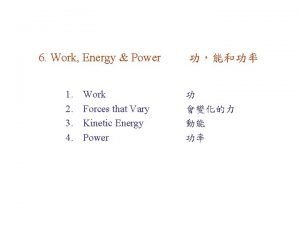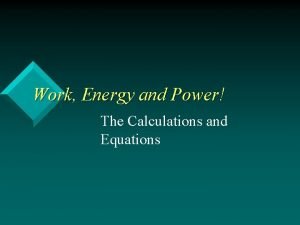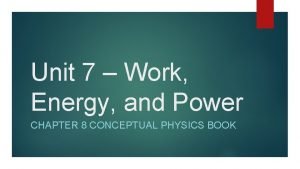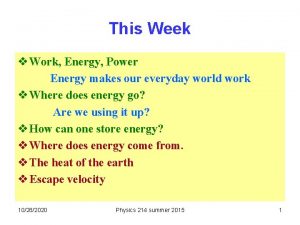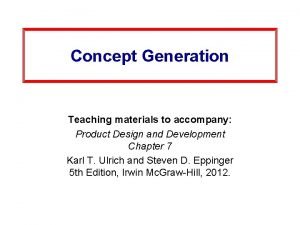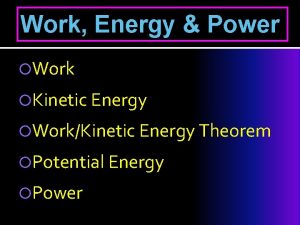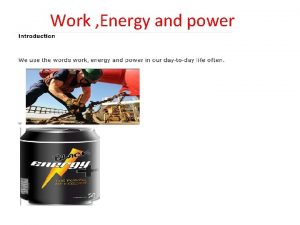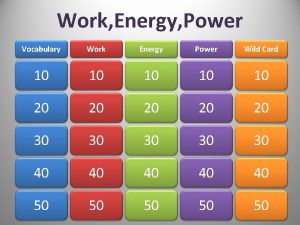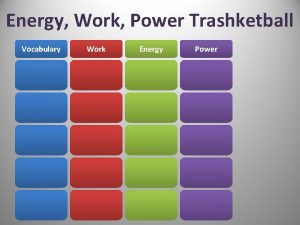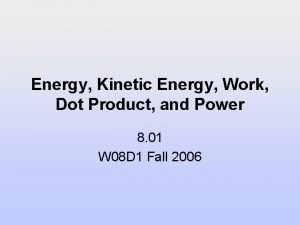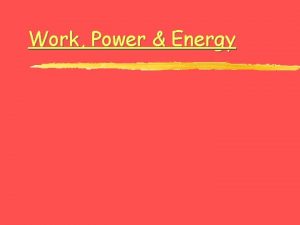Work Power Energy Work Concepts Work W product

















- Slides: 17

Work, Power, Energy

Work Concepts • Work (W) ~ product of the force exerted on an object and the distance the object moves in the direction of the force. – W is transfer of energy by mechanical means. – W is done on an object only if it moves in the direction of the force (or parallel to the force). – If the force and displacement are in opposite directions, the work done is negative. – Only the component of the force in the direction of the motion does work.

Work Formulas Work = Force x displacement W = Fd F d 1 Joule (J) = 1 Newton x meter (N m)

If force is exerted at an angle, use only the component of force that is parallel to the displacement: F d Since the displacement is horizontal (x direction), use only the horizontal component of force. F θ Fx Fy W x = F x dx W = (Fcos )d

Power • Power (P) ~ rate at which work is done or rate at which energy is transferred. Measured in watts. – Watt (W) ~ one joule of energy transferred in one second. Power = Work / time Units: 1 watt = 1 joule / second (J/s) 1 watt = 1 N m / s

Ideal Machines • Ideal machines exist only in a frictionless, air resistance-less world. • No energy or work is lost to the system through outside forces • For ideal machines: Work input = Work out put so: Findin = Fout dout

Efficiency • Efficiency ~ ratio of work output to work input expressed in percent. • Ratio of final energy to initial energy efficiency = (Wout / Win) * 100 Or efficiency = (Ef / Ei)*100

Types of Energy èMechanical Energy é Kinetic Energy é Elastic Potential Energy é Gravitational Potential Energy èChemical Potential Energy èThermal (Heat) Energy

Kinetic Energy -the energy an object has due to its motion KE = ½ m v 2 KE – kinetic energy, J m – mass, kg V – speed, m/s

Potential Energy Potential energy is the energy an object has because of its position, shape, or form

Gravitational P E GPE = gravitational potential energy, J GPE = m g h m = mass, kg GPE = Fg h h = height above reference level, m g = accleration due to gravity, m/s 2 (+h if above ref. , -h if below ref. ) Gravitational potential energy depends on the weight of the body (mass and g) and its separation from Earth (h)

Elastic Potential Energy • Energy stored in an elastic object that is stretched or compressed. • An elastic object is one that can be stretched or compressed and will return to its original or relaxed length. EPE = ½ k x 2 EPE - elastic potential energy, J k - the elastic or spring constant, N/m (indicates how easily a material stretches or compresses) ‘higher k, stiffer’ x - the distance that the object is stretched or compressed from its relaxed length (stretched length – relaxed length)

Mechanical Energy Mechanical energy is the energy which is possessed by an object due to its motion or its stored energy of position, shape, or form Mechanical Energy = KE + PE ME = KE + GPE + EPE

Law of Conservation of Energy • Energy can not be created or destroyed. • The total energy remains constant. • Energy can change forms. • Assumes a closed, isolated system. • We will only use mechanical energy. MEinitial = ME, final KEi + GPEi + EPEi = KEf + GPEf +EPEf ½ mvi 2 + mghi + ½ kxi 2 = ½ mvf 2 + mghf + ½ kxf 2

Work-Energy Theorem If work is done on an object (by the net force), its energy is changed. The change in energy is equal to the work done. Work = Δ KE F d = KEf – KEi F d = ½ m v f 2 – ½ m v i 2

Work Energy Theorem • When work is done, potential energy can also be changed.

Work Energy Theorem • When work is done, elastic potential energy can also be changed.
 Power triangle
Power triangle Energy energy transfer and general energy analysis
Energy energy transfer and general energy analysis Energy energy transfer and general energy analysis
Energy energy transfer and general energy analysis 0kei0
0kei0 Work, power and energy activities
Work, power and energy activities Unit of resistivity
Unit of resistivity Physics 2204 unit 3: work, power, energy
Physics 2204 unit 3: work, power, energy Work done definition
Work done definition How are work and power related
How are work and power related Work power energy and machines
Work power energy and machines F d cos theta
F d cos theta Work power
Work power Work energy power equations
Work energy power equations Jenis usaha apa
Jenis usaha apa F= ma units
F= ma units Generate product concept example
Generate product concept example Section 1 work and machines section 2 describing energy
Section 1 work and machines section 2 describing energy Definition of renewable energy source
Definition of renewable energy source








